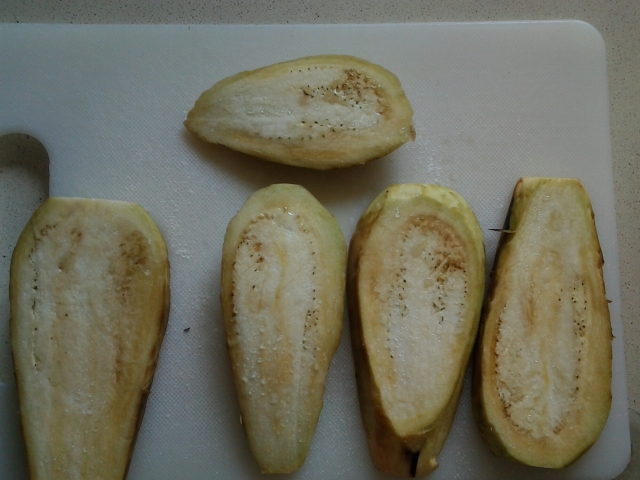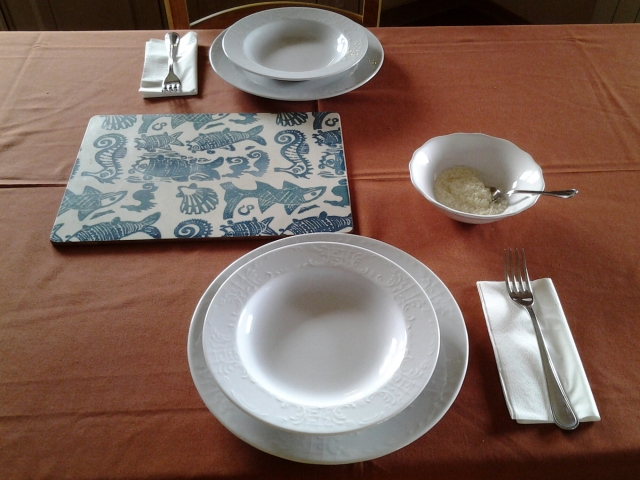Yesterday was Cleaning Day and I hate Cleaning Day! Perhaps I should qualify that: I hate the process but I love the result. There is nothing like the smell of a freshly dusted and polished house or the feel of a newly washed floor underfoot. Anyway, since it was a hard day cleaning, it had to be an easy day cooking and nothing is easier than pasta, in my book.
A quick look in the fridge revealed an aubergine begging to be eaten and a plan began to form. This recipe is based on a recipe from an Italian recipe book, but I tweaked it with the addition of bacon bits. My daughter has the firm belief that there’s nothing that can’t be improved with the addition of bacon, and I tend to agree. If you want the authentic recipe, just leave out the bacon. The ingredients are enough for two hungry people as a main meal. If you serve this as a primo, Italian style, then it would probably serve three or four people.
Ingredients :
1 aubergine
1 onion
100g bacon bits
250g spaghetti
Tomato passata
A few fresh basil leaves finely chopped
Salt
A small mozzarella ball (about 125g)
Chilli pepper to taste
Peel and slice the aubergines in thick slices. Salt them and leave them to draw for twenty minutes.

In the meantime, peel and dice the onion and the bacon if it isn’t already diced. Prepare the basil leaves and keep them aside.

Fry the bacon and onion together. You can add a little oil if needed. I always fry my onion until it is soft as I don’t like it crunchy, but you do it the way you like it. It should be golden and delicious. Mmmmm….can you smell that delicious onion and bacon smell?

Now prepare the aubergine. Rinse and dry the slices well. Cut them into squares and fry them in a little hot oil. They will absorb the oil. When they have browned all over, drain them on kitchen paper. Be careful not to let them brown too much!

When they are ready, add them to the pan with the bacon and onion. Add the passata, salt and chilli pepper to taste and allow to cook until the brinjal is cooked through and the sauce is rich and glossy.

You need a large pot because pasta needs to cook in lots of water. None of this shoving it in a tiny pot. You need one this size and the water must be boiling with a rolling boil before you put the pasta in. Add lots of salt to the water. According to one italian saying, the pasta water should be as salty a the sea.
Add the spaghetti to the pot in one piece. Do not break it or you’ll spoil the chance to eat it like an italian, slowly slurping in those stray strands that wouldn’t twirl on the fork. The strands slowly sink into the water as they soften and you can help them with a fork, turning and mixing them slowly. Put the pot lid on to bring the water back to the boil quickly, but watch the pot as it boils over easily. Once you have a rolling boil again, you can remove the lid. Use a long fork or spaghetti spoon to agitate and turn the pasta now and then while it cooks. This will help prevent the strands from sticking to each other. Cook until the spaghetti is cooked enough for you. It’s a personal thing. Al dente for most Italians means that there must still be a hard bite in the centre of the pasta. I don’t like that and cook until that bite is gone but the pasta is still relatively firm. About 14 minutes for this pasta.
While the pasta is cooking, dice the mozzarella into small dices.

Drain the pasta in a colander, keeping aside a little of the cooking water to add to your sauce if it’s too thick or too little and needs extra liquid. This is a trick all Italian mammas know and use to make a sauce stretch. It also helps make a sauce creamier. Put the spaghetti back in the pot and slowly add the hot pasta sauce, the diced mozzarella and the chopped basil, mixing gently. Add only enough to give the pasta a generous coating, not to drown it in sauce. I used about half the sauce and froze the rest for another meal.








